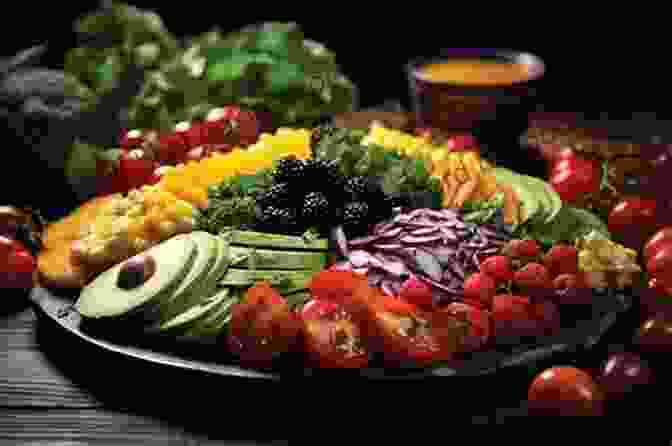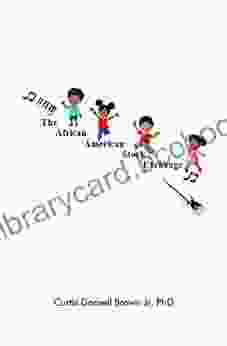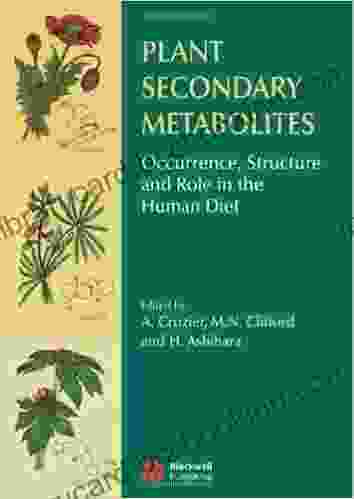Occurrence, Structure, and Role of Dietary Fiber in the Human Diet: A Comprehensive Guide


Dietary fiber, often referred to as roughage, is a type of carbohydrate that cannot be digested by the human body. It plays a crucial role in maintaining overall health and well-being. This comprehensive article explores the occurrence, structure, and diverse functions of dietary fiber in the human diet.
4.7 out of 5
| Language | : | English |
| File size | : | 7947 KB |
| Text-to-Speech | : | Enabled |
| Print length | : | 384 pages |
| Lending | : | Enabled |
| Screen Reader | : | Supported |
Occurrence and Sources of Dietary Fiber
Dietary fiber is abundant in plant foods, including fruits, vegetables, whole grains, legumes, and nuts. Specific food sources rich in fiber include:
- Fruits: Berries, apples, bananas, pears, citrus fruits
- Vegetables: Broccoli, cauliflower, carrots, celery, leafy greens
- Whole grains: Brown rice, oatmeal, whole-wheat bread, quinoa
- Legumes: Beans, lentils, peas, chickpeas
- Nuts: Almonds, walnuts, pistachios, chia seeds
Structure and Types of Dietary Fiber
Dietary fiber consists of two main types: soluble and insoluble. These types differ in their solubility in water and their physiological effects.
Soluble Fiber: This type of fiber dissolves in water, forming a gel-like substance in the digestive tract. It helps:
- Lower cholesterol levels
- Control blood sugar levels
- Promote satiety and reduce appetite
Found in: Oats, barley, apples, citrus fruits
Insoluble Fiber: This type of fiber does not dissolve in water. It adds bulk to stool, promoting regularity and preventing constipation.
- Adds bulk to stool
- Promotes bowel regularity
- May reduce the risk of certain cancers
Found in: Whole grains, vegetables, nuts
Physiological Roles and Health Benefits of Dietary Fiber
Dietary fiber serves numerous vital functions in the human body, including:
Digestive Health: Fiber helps to regulate bowel movements, preventing constipation and promoting a healthy digestive system. It also acts as a prebiotic, feeding beneficial bacteria in the gut.
Cardiovascular Health: Soluble fiber helps to lower cholesterol levels, reducing the risk of heart disease and stroke.
Blood Sugar Control: Soluble fiber slows down the absorption of glucose into the bloodstream, helping to maintain stable blood sugar levels. This can improve insulin sensitivity and reduce the risk of type 2 diabetes.
Weight Management: Fiber promotes satiety and reduces appetite, contributing to weight management efforts.
Cancer Prevention: Insoluble fiber may help to reduce the risk of certain types of cancer, such as colon cancer.
Recommended Intake and Health Implications
The recommended daily intake of dietary fiber varies depending on age, sex, and overall health. Generally, adults should aim for 25-30 grams of fiber per day.
Inadequate Fiber Intake: A low fiber intake can lead to constipation, diverticular disease, and other digestive issues. It can also increase the risk of heart disease, obesity, and certain types of cancer.
Excess Fiber Intake: Consuming excessive amounts of fiber can cause gas, bloating, and abdominal discomfort. It can also interfere with the absorption of certain nutrients, such as iron and calcium.
Tips for Increasing Fiber Intake
Incorporating more dietary fiber into your diet can be easy and rewarding. Here are some tips:
- Include fruits and vegetables in every meal and snack.
- Choose whole-grain products over refined grains.
- Add beans, lentils, or peas to salads, soups, and stews.
- Snack on nuts and seeds.
- Read food labels and choose products high in fiber.
Dietary fiber is an essential nutrient that plays a vital role in maintaining overall health and well-being. Understanding the occurrence, structure, and functions of dietary fiber empowers individuals to make informed choices about their diet. By incorporating adequate amounts of dietary fiber into their daily intake, individuals can reap its numerous health benefits, improving digestive health, cardiovascular function, blood sugar control, weight management, and reducing the risk of chronic diseases.
4.7 out of 5
| Language | : | English |
| File size | : | 7947 KB |
| Text-to-Speech | : | Enabled |
| Print length | : | 384 pages |
| Lending | : | Enabled |
| Screen Reader | : | Supported |
Do you want to contribute by writing guest posts on this blog?
Please contact us and send us a resume of previous articles that you have written.
 Book
Book Novel
Novel Page
Page Chapter
Chapter Text
Text Story
Story Genre
Genre Reader
Reader Library
Library Paperback
Paperback E-book
E-book Magazine
Magazine Newspaper
Newspaper Paragraph
Paragraph Sentence
Sentence Bookmark
Bookmark Shelf
Shelf Glossary
Glossary Bibliography
Bibliography Foreword
Foreword Preface
Preface Synopsis
Synopsis Annotation
Annotation Footnote
Footnote Manuscript
Manuscript Scroll
Scroll Codex
Codex Tome
Tome Bestseller
Bestseller Classics
Classics Library card
Library card Narrative
Narrative Biography
Biography Autobiography
Autobiography Memoir
Memoir Reference
Reference Encyclopedia
Encyclopedia Cynthia Galey Peck
Cynthia Galey Peck Constance Classen
Constance Classen Dan Richer
Dan Richer Dana K White
Dana K White Dan Purser Md
Dan Purser Md Clay Risen
Clay Risen Craig Liebenson
Craig Liebenson Cp Lowe
Cp Lowe Dana Fox
Dana Fox Craig Smith
Craig Smith Cinelle Barnes
Cinelle Barnes D J Steinberg
D J Steinberg Dan Flores
Dan Flores D A Miller
D A Miller Dan Blackburn
Dan Blackburn Cute Broidery Company
Cute Broidery Company Cristy C Road
Cristy C Road Cleve Johnson
Cleve Johnson Dale Marie Bryan
Dale Marie Bryan D J Machale
D J Machale
Light bulbAdvertise smarter! Our strategic ad space ensures maximum exposure. Reserve your spot today!

 Osamu DazaiThe African American Stock Exchange: A Catalyst for Black Wealth and Economic...
Osamu DazaiThe African American Stock Exchange: A Catalyst for Black Wealth and Economic...
 Donald WardVisual Guide For Tennis Players Volume 1: The Complete Guide to Improve Your...
Donald WardVisual Guide For Tennis Players Volume 1: The Complete Guide to Improve Your... Walter SimmonsFollow ·15.7k
Walter SimmonsFollow ·15.7k Dion ReedFollow ·3.3k
Dion ReedFollow ·3.3k Ray BlairFollow ·4k
Ray BlairFollow ·4k Robert FrostFollow ·15.1k
Robert FrostFollow ·15.1k August HayesFollow ·13.5k
August HayesFollow ·13.5k Dale MitchellFollow ·8k
Dale MitchellFollow ·8k Joe SimmonsFollow ·13.5k
Joe SimmonsFollow ·13.5k Henry HayesFollow ·19.9k
Henry HayesFollow ·19.9k

 Donald Ward
Donald WardVeteran Investment Advisor Reflects On Money
Unlocking Financial Wisdom...

 Fernando Pessoa
Fernando PessoaUnlock the Secrets of Value Investing with "University of...
In the realm of investing, there stands an...

 Jorge Luis Borges
Jorge Luis BorgesMaster Spanish Vocabulary with Ap Spanish Flashcards...
Are you eager to expand your Spanish...

 Roger Turner
Roger TurnerPlay Like a Pro: The Ultimate Guide to Becoming a Master...
Are you ready to...
4.7 out of 5
| Language | : | English |
| File size | : | 7947 KB |
| Text-to-Speech | : | Enabled |
| Print length | : | 384 pages |
| Lending | : | Enabled |
| Screen Reader | : | Supported |












